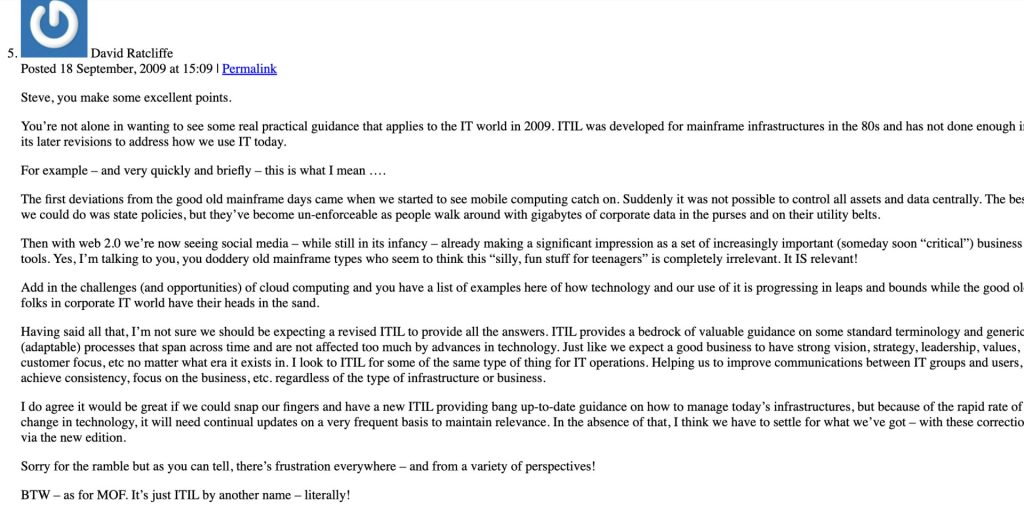2024: Is the ITIL make-over like putting lipstick on a pig?
Back in 2009, I wrote this piece on Is the ITIL make-over like putting lipstick on a pig?
The question is, although some of the names have changed, are we still seeing the same ideology and resistance?
—
OGC are planning a new edition of the ITIL v3 publications.
Is it a minor revision with not much impact on anyone (then why do it?)
Or, are the changes substantial enough to make this a revenue-generating activity, forcing priests/practitioners to buy new bibles/publications from the church/itSMF?
Even worse, whether the changes or minor or major, is this a wasted opportunity to make ITIL more relevant for today’s IT infrastructure?
Where’s today’s IT Infrastructure in ITIL?
Since 2004 I’ve been using ITIL as “a language” to integrate VMware virtualization solutions into large enterprises. In all honesty, it’s caused more problems than providing solutions:
- 100% of companies I’ve worked with have only partial understanding of ITIL and varied application of it’s vague best practices (Incident and Problem the wrong way round, being one).
- 100% of companies think, when I mention ITIL, that I’m an ITIL prima-donna somehow hellbent on turning them into an ITIL shop – whatever that means, because ITIL is hardly a reference architecture!
- 100% of companies realise that virtualization changes their IT infrastructure, but ITIL is useless in this regard because it doesn’t talk about IT infrastructure in enough detail.
I think the last point is the killer for me: how can a best practice series called IT Infrastructure Library have very little about IT Infrastructure in it?
If I had the time to analyse the the ITIL publications I would probably find <10% of the content is directly related to IT infrastructure: most of it is about how to develop processes, service management, roles and responsibilities, etc.
That is far to unbalanced and is the root cause of why ITIL is perceived as too high-level, and that there is a requirement to have an itSMF priest (ITIL practitioner) to interpret the bible (ITIL publications) on the layman’s (any IT shop) behalf. Read more about Is ITIL “Gerin Oil” for IT?
I wish ITIL was more referenceable, more pragmatic and more relevant for today’s infrastructure. Here’s some things I’d like ITIL to cover:
- Virtual Infrastructure – how the service and server lifecycles are transformed, and how they impact all the other ITSM processes from SLM through Finance through to Config Management.
- Cloud Computing – the epitomy of managing IT as a service, this is a great opportunity for ITIL to provide a best practice framework.
Yes, you heard me, I’d like to see a library of best practice reference frameworks for IT Infrastructure. That’s right: instead of one “holy of holies” that tries to boil the ocean and cover the design and development of all and any services, I’d like to see solution-specific examples like the two above. Let’s go a bit further and look at some other more specific examples:
- Remote Office Branch Office Operations – how to design, deploy and manage ROBO for banking and retail.
- Offshore Desktop Operations – what do you have to wrap around VDI technology to make this work?
- Application Development Cloud – how would you provide a self-service operations cloud model to developers to turbo-boost their productivity?
These are just three examples from a laundry list of solutions that require different operational models: one size does not fit all.
- If ITIL can’t give me an advantage in deploying these models, then why use ITIL?
- If ITIL restricts me from deploying these models, then why use ITIL?
- If ITIL doesn’t apply to these models, why use ITIL?
- If it takes me more effort to apply ITIL to these models than not using ITIL, why use ITIL?
The proposed changes to ITIL will not go in the direction that I (and my customers) would like. I don’t think ITIL will ever go in that direction: instead I think the current proposed changes are merely lipstick on a pig that might develop into a revenue generating opportunity for the itSMF.
But, being a glass-half-full kinda guy, I see this gap left by OGC and iSMF as opportunity
Imagine if a group of people collaborated to produce an ITIL-esque, but practical and prescriptive, guide to the IT Infrastructure solutions above? I bet you they would be best sellers around the world.
Worthy comments:
Dave Convery:

David Ratcliffe:


